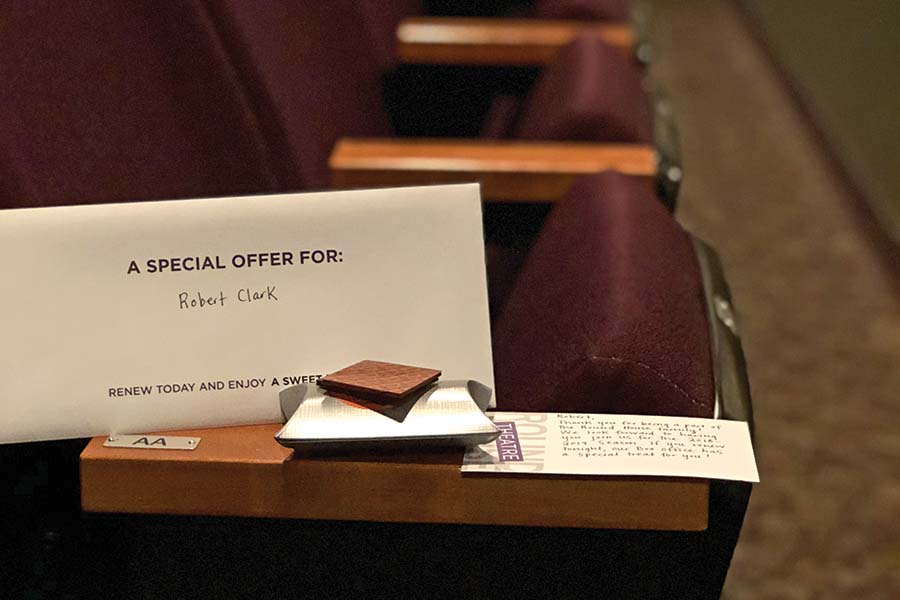A smooth customer relationship management (CRM) system is like a theatre’s super brain, tracking patron habits, selling tickets, and enabling user-specific marketing.
At the Round House Theatre in Bethesda, Md., CRM helps the box office and Anna Mills Russell, director of marketing and communications, know when to apply a personal touch—like leaving first-time buyers a surprise gift from a local chocolatier. “I think it goes for any CRM system,” she says. “When you know how to use it properly, you get the data that you need out of it.”
There are hundreds of ways to manage a box office and customer data, from using software like Tessitura, Spektrix, Theatre Manager, Blackbaud, and PatronBase, to employing a DIY-style that mixes PayPal and spreadsheets. But without a strong CRM or box office plan, the show may go on—for empty houses.
The technology is still fairly new, but one of the largest players is Tessitura, which serves 600-plus arts organizations and about 160 theatres (it was created by the Metropolitan Opera in the 1990s). Tessitura serves all kinds of companies, some with as few as five employees and others with as many as 1,000, says Jack Rubin, Tessitura’s longtime CEO. He will not comment on pricing because each organization receives a unique quote based on a number of factors, including size.
Sometimes it’s not just one organization per Tessitura account; some serve multiple institutions. James Haskins, managing director of the Wilma Theater, helped organize the Philadelphia Regional Arts Consortium more than 10 years ago, a network of 14 theatres. While the Wilma holds the Tessitura license, the costs of the system are spread among its 14 theatres. “We can get very caught up in the technology and all that it’s able to do, but I’ve been very insistent that we remain customer-service-friendly,” Haskins says.
Even with a strong CRM system, patrons still have to get to the theatre. Gwydion Suilebhan, director of brand and marketing at Woolly Mammoth Theatre Company in Washington, D.C., was inspired by scheduling apps like Doodle and payment apps like Venmo, both indications of changing patron behavior. So the theatre created its own app, called HERD.
Launched last fall with funding from a Wallace Foundation grant, HERD helps friends find a performance date that works best for them, lock in a price, and split the cost. The theatre collects all contact information. Woolly hopes to one day license the technology, but Suilebhan says it’s not about creating additional revenue.
“This is about enabling a different kind of social experience of going to the theatre,” Suilebhan says. “This is about encouraging repeat visits to the theatre.”
New ways of encouraging theatregoers does not mean the traditional season subscription model is dead. But it is changing to include flexible passes, build-your-own seasons, and mini-subscriptions. Following a 46 percent drop in subscribers at the Delaware Theatre Company, new executive director Bud Martin and TRG Arts consulting firm offered lapsed subscribers a deal: three plays for $75. The campaign, as well as programming, led to a 41 percent increase in revenue from tickets and subscribers and a 31 percent increase in subscriber admissions. Tickets are available on DTC’s website, but Carolina Millard, patron experience and marketing manager, encourages potential buyers to call the box office to speak to a live person on the line. She keeps a list of reminders and suggested questions for callers as the desktop background of the box office’s two computers.
“I consistently find that people in the box office, if they can speak to the passion and the art and the work, it’s a lot more of an interesting conversation,” Millard says.
Still, it can be hard to go out when it’s easy to stay at home. A Contemporary Theatre in Seattle offers patrons a monthly subscription plan similar to what they might pay to stream movies from their couch. For as low as $30 a month, ACTPass members view as much theatre as they desire. They just need to reserve a seat. It’s similar to New York Theatre Workshop’s recently launched pay-as-you-go membership.
Other theatres look to help their subscribers see theatre—even miles away. The National Stages Program offers discounts and perks to travelers who have memberships with one of 24 participating theatres around the country.
Whether modernizing technology or creating concierge experiences, any box office system should have as its prime directive to remove barriers for patrons.
“When it’s easier to buy a ticket, more tickets get sold,” says Ron Evans, president of Group of Minds, a California-based nonprofit consulting firm. One of the biggest mistakes Evans sees theatres making when choosing a system is relying on another theatre’s recommendation. Each organization has different needs, and depending on the mission, fancy systems and loyalty programs aren’t always needed.
“Theatre is adaptable to any way of telling a story. You don’t have to have high-tech software to do that,” Evans says.


